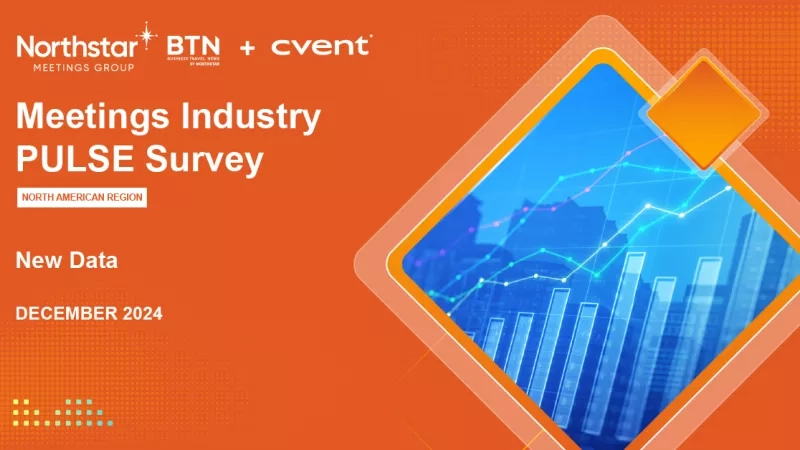As with any part of an event planner's playbook, things are ever-changing in the venue sourcing landscape. From competition for space and understaffed venues to juggling tighter budgets and rising costs, your venue sourcing strategy from last year isn't going to help you address the new challenges you'll be facing this year.
Having the right tools at your disposal to will help immensely, even during times of great uncertainty.
In this post, we’ll share the ways that technology can make sourcing and choose the right venue for your in-person events less time-consuming, more streamlined, and ultimately more successful. Whether you’re new to the industry or a seasoned professional, efficiency and working with venues will be critical to sourcing the right venue (or destination).
6 ways event tech can boost your venue sourcing strategy
While there are many traditional paths to finding a venue, they aren't what you'd call "strategic," (or at all efficient). If you're still hunting down event venuesby going through your list of personal contacts and emailing event requirements, or conducting time-consuming Google searches and viewing individual hotel websites, you're doing yourself no favors.
Utilizing venue sourcing technology is the quickest and easiest way to set yourself (and your events) up for success. Here are 6 venue sourcing technology features that will help you up your sourcing game and make the entire process faster, cheaper, and more enjoyable for you and potential partners.
1. Search for destinations and venues at your fingertips
While “perfect” may seem relative, using technology when sourcing venues will get you closer to your goals than a more manual approach will. The narrowing process, however necessary, can quickly become overwhelming without the aid of tech. At the end of the day, you need to find the destination that meets your group needs and will promote maximum attendee satisfaction.
A venue sourcing platform provides a truly effective online marketplace, giving you massive sourcing power. With a powerful database at your fingertips, the exhaustive (and exhausting) process of manually searching from dozens of windows open on your browser disappears.
Pro Tip: Consider unique event spaces as you search. Non-traditional venues can offer cost savings, enhanced opportunities to personalize your event space, and exciting experiences for attendees, which is why 49% of planners say they're sourcing special event venues.
2. Narrow down your choices in seconds
Venue sourcing technology provides all the information you need, all in one place. Critical information like average hotel room rates, average daily meal costs, the total number of sleeping rooms, activities and entertainment, star ratings, promotions, and pictures of venues are all available to review and dissect, with just a few clicks of your mouse.
For example, if you need a Northeast United States beach destination that has 200+ sleeping rooms and at least 10,000 square feet of meeting space, within seconds, your options will be narrowed down to three locations: Atlantic City, New Jersey; Long Island, New York; Portland, Maine. What could take hours just took seconds.
Pro Tip: Not sure where in the world to hold your event? Check out these top meeting destinations planners are loving!
3. Send your RFPs in a flash
If you’ve reached this point, you’ve done your homework by narrowing down one or two destinations and a handful of hotels and conference centers that fit the bill. By doing your research, you should have limited your shortlist to a handful of venues that really fit your needs.
As we mentioned previously, tech can make this faster and more efficient when you need those qualities the most. Now it is time to issue an electronic Request for Proposal (RFP) to each venue and see what responses come flowing in. You can reach out to all of your prospective venues at once with the same key event details.
Another upside here is that venues realize that when they receive RFPs via sourcing technology, they’re competing for business with other venues, so their response time is much quicker than usual. This is a crucial benefit, with 80% of planners saying they want responses to RFPs in four days or less.
Bonus: by making your RFP as complete as possible, you’ll get a more detailed response, eliminating rounds of back and forth with the venues.
Pro Tip: Create a library of custom questions and require responses from hotels so you know who has agreed to your terms and conditions and mitigate risk by including cancellation clauses on all your RFPs.
4. Evaluate your RFP responses more efficiently
If you don’t use an RFP tool, hotel proposals can come in a myriad of ways, some easier to read than others. These days, the added stress of assembling various proposals and different formats is completely unnecessary. Using a digital solution will ensure not only that hotels send proposals in a standard format, but also that you can compare each proposal side-by-side and make negotiating easier and less stressful.
Pro Tip: Remember to also work with yourCVB, DMO, or DMC. They are experts on the destination and can answer many of your questions.
5. Conduct virtual site visits with real-time collaboration
While sourcing tech can give you the hotel data you need (when the venue was built, total meeting space, nearby attractions), site visits are important. Of course, the cost of site visits can add up and eat into your event budget, so it's imperative you're only visiting sites in person when you're already pretty sure it's the right choice.
The good news is that there are ways to conduct virtual site visits before you commit to the full in-person visit. You'll start by using your venue sourcing tech to find venues that have the spaces you need, including rooms with ample capacity limits and spaces designed for the event or session formats you're envisioning.
Once you've worked with your prospective venues to collect floor plans and diagrams, you can collaborate to maximize space available, virtually. This way, you can ensure your shortlist of venues can accommodate your size event and set-up before ever seeing the space in-person.
Pro Tip: Use 3D event diagramming tools to collaborate in real-time about setup, seating, and more. As with in-person site visits, always have all your critical questions ready beforehand.
6. Centralize all your venue data
A significant benefit of digital sourcing is the ability to store all of your historical data in a single system of record. This allows you to easily access all the information you need to make informed choices in the near and distant future. Use your technology as a place to store all previous bids and contracted rates that you can use as leverage when you are negotiating with your suppliers—this will be even more important to your bottom line!
Pro Tip: When all your event venue data is in one place, you'll never have to worry about finding the best POC for a venue or remembering which venues you've already decided aren't for you.
Venue sourcing tech: A more strategic way to choose event venues
Streamlining the way you source venues—one of the most important and costly aspects of event planning—is essential. With venue sourcing technology, you can put so much of the stress that comes with manual sourcing to rest and save yourself money when it comes time to negotiate with and choose your venues.
Want more tips and better venue sourcing strategies? Check out these 10 tips to source successfully in 2025.





